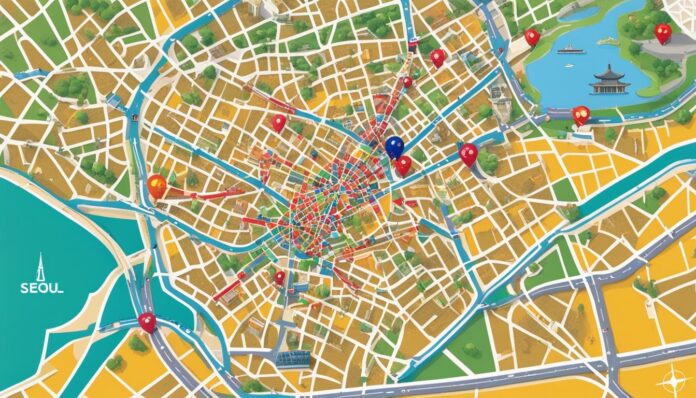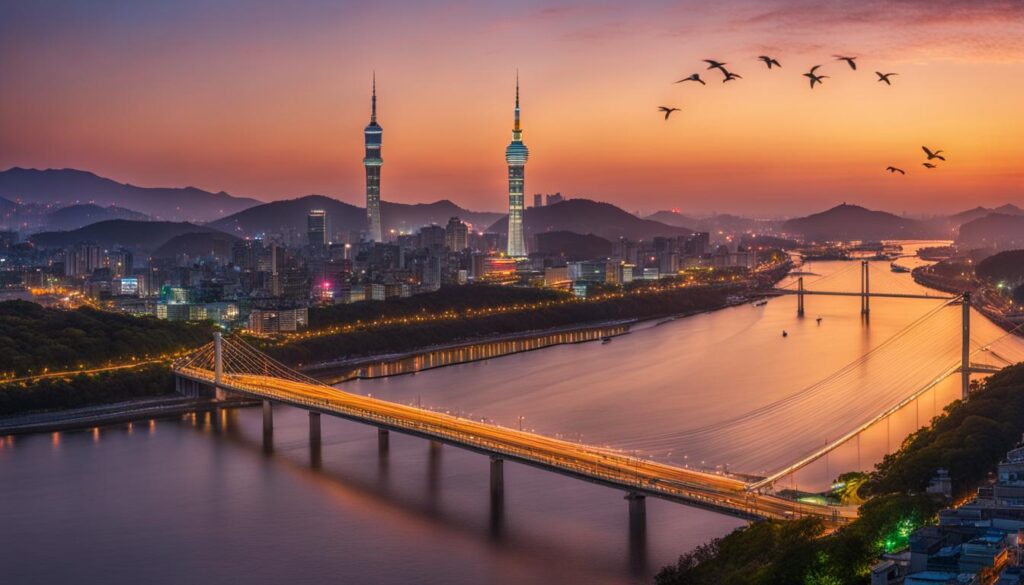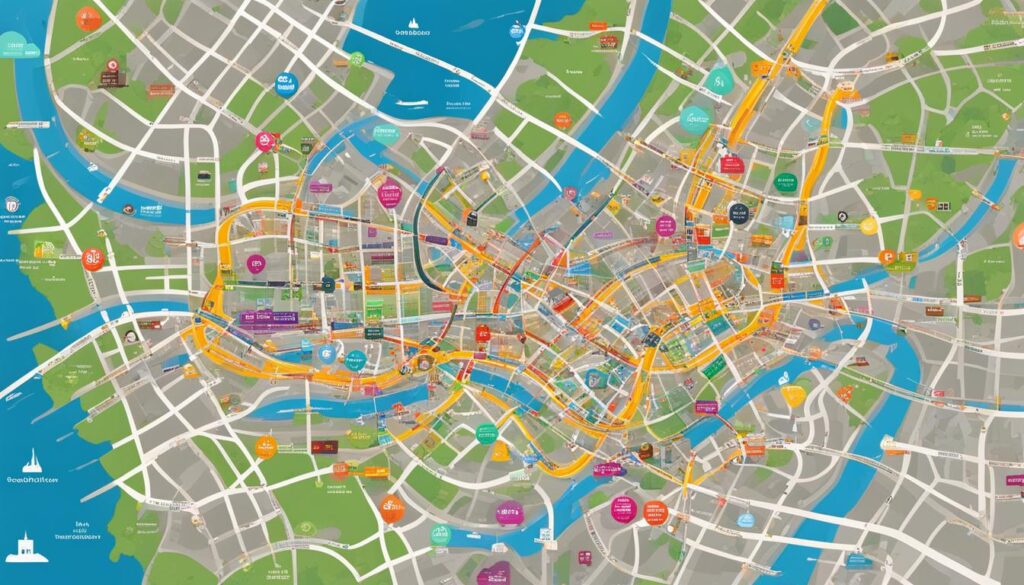If you’re planning a trip to Seoul, South Korea, and want to make the most of your time there, you need a well-crafted itinerary. In this expertly crafted Seoul itinerary, we will guide you through five days of scenic exploration in the vibrant capital city of South Korea.
From exploring traditional markets to visiting serene temples, hiking through beautiful parks, and indulging in authentic cuisine, we have included all the must-see attractions and activities in our itinerary. With our plan, you will experience the best of Seoul in just five days.
Get ready for an immersive cultural experience, bustling markets, tranquil temples, captivating views, and unforgettable memories. Our itinerary will also provide you with tips on accommodation, transportation, authentic Korean cuisine, day trips from Seoul, cultural etiquette and customs, and practical information for a safe and comfortable trip.
Follow our Seoul itinerary for five days of a memorable and scenic exploration in South Korea’s capital city.
Day 1: Immersive Cultural Experience
On your first day in Seoul, you’ll embark on an immersive cultural experience that will introduce you to some of the city’s must-see attractions. We recommend starting your day early to make the most of your time in this vibrant city.
Gyeongbokgung Palace
Your first stop should be at Gyeongbokgung Palace, one of Seoul’s most iconic landmarks. Built-in 1395, the palace served as the main royal palace during the Joseon Dynasty. Here, you’ll have the opportunity to witness the Changing of the Guard Ceremony and explore the palace’s stunning architecture and beautiful gardens.
Bukchon Hanok Village
After visiting Gyeongbokgung Palace, take a short walk to Bukchon Hanok Village, a traditional Korean village with beautiful hanok houses. Stroll through the narrow alleys and observe the traditional architecture that dates back to the Joseon Dynasty. You can also take part in a traditional tea ceremony, try on a hanbok (traditional Korean clothing), or visit a traditional crafts museum.
Insadong
To end your first day, visit Insadong, one of Seoul’s most charming neighborhoods. You’ll find a mix of traditional and modern shops, galleries, and restaurants. Try some street food, shop for souvenirs, and experience the lively and colorful atmosphere of this historic district.
By the end of the day, you’ll have explored some of Seoul’s most popular and culturally significant sites. Stay tuned for day two where we’ll explore the bustling markets of Seoul.
Day 3: Serenity in Temples
Seoul is not just about bustling markets and vibrant urban life. It’s also home to some of the most serene temples you’ll ever see. On your third day, satisfy your spiritual side and explore Seoul’s stunning temples.
Temple Tours
Temple tours are a must-do in Seoul, especially if you’re on limited time. This is because there’s a great selection of temples that offer unique experiences. Here are some temples that are worth visiting in Seoul:
| Temple | Highlights |
|---|---|
Jogyesa Temple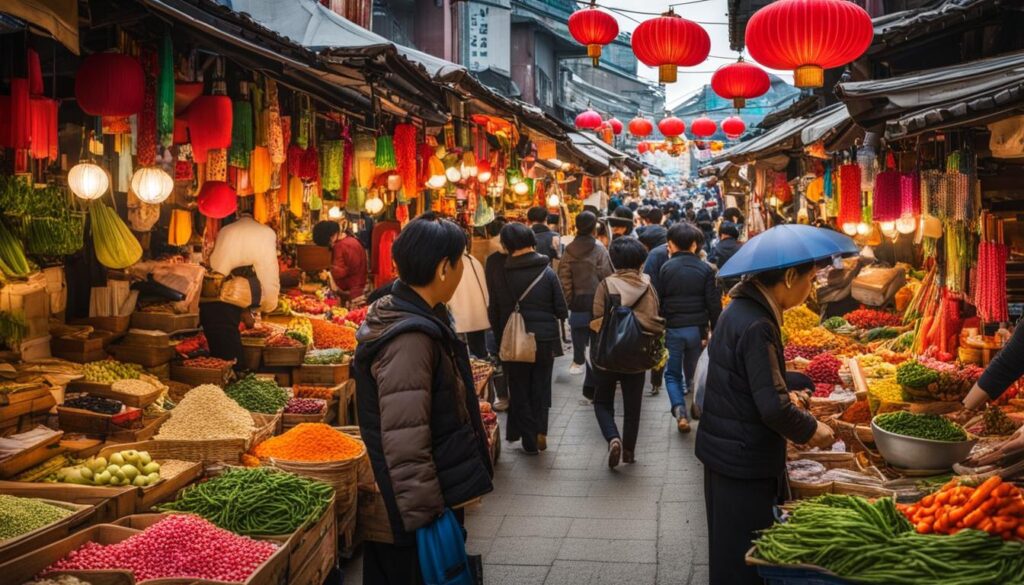 |
|
| Bongeunsa Temple |
|
Jongmyo Shrine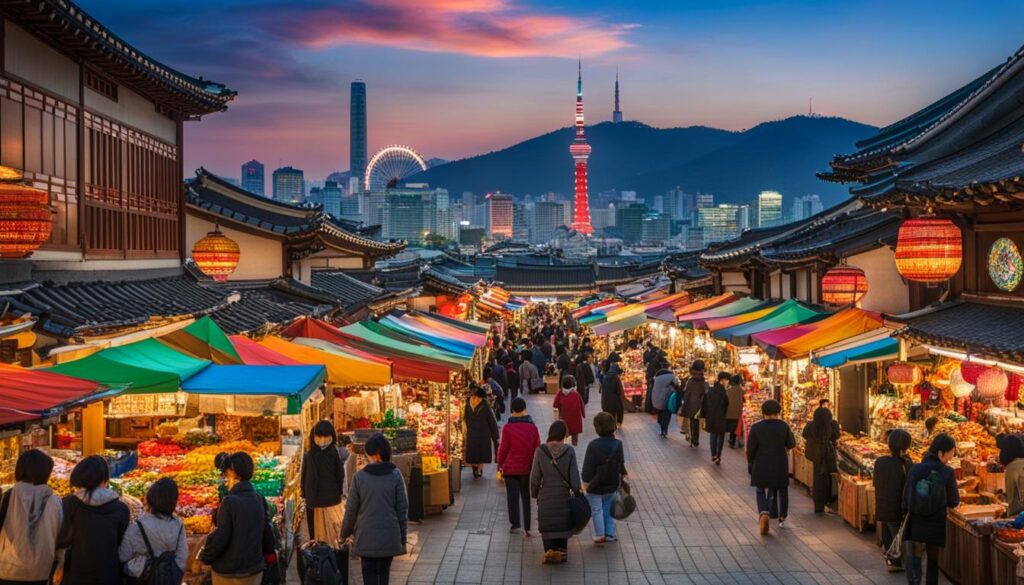 |
|
If you’re interested in Korean culture and history, these temples are not to be missed. Check with your hotel for possible temple tours or join a group tour that can take you to several temples.
Cultural Insights
Visiting temples is a wonderful way to learn about Korea’s rich cultural heritage and to observe traditional customs and rituals. Here are a few tips to keep in mind:
“When entering the temple, bow twice to show respect to Buddha. Take off your shoes before entering the temple buildings, and dress modestly, covering your shoulders and knees. Remember that some areas of the temple are off-limits to tourists, so please be respectful and follow the temple rules.
By following these simple guidelines, you’ll be able to fully appreciate the beauty and serenity of Seoul’s temples while showing respect for Korean culture and tradition.
Markets Near Temples
Many temples are located in or near bustling markets, making it easy to experience both the spiritual and commercial aspects of Korean culture. Here are some of the bustling markets you can visit near Seoul’s temples:
- Insadong Market – Located near Jogyesa Temple
- Gwangjang Market – Located near Jongmyo Shrine
- Cheonggyecheon Market – Located near Bongeunsa Temple
These markets are perfect for enjoying local Korean street food, traditional crafts, and souvenirs. Exploring temples and markets in the same day is a great way to get an authentic feel for Seoul’s vibrant culture.
Day 3 of your Seoul itinerary promises to be a tranquil and insightful day. You’ll get to experience the beauty of Seoul’s serene temples, learn about Korean culture and history, and taste some of the best street food in the city. Get ready to be amazed!
Day 3: Serenity in Temples
On your third day in Seoul, take a break from the bustling city and explore the serene temples that offer an oasis of tranquility. Seoul’s temples date back to the 14th century and showcase stunning architecture, traditional rituals, and rich history.
Jogyesa Temple
Your first stop, Jogyesa Temple, is located in the heart of Seoul and is famous for its impressive gate, Daeungjeon, which houses three large Buddha statues. Jogyesa Temple is the center of Zen Buddhism in Korea and offers a peaceful and spiritual atmosphere.
Bongeunsa Temple
Next on the recommended Seoul itinerary is Bongeunsa Temple, located in the Gangnam district. This temple features beautiful gardens and magnificent pagodas. The temple also offers meditation classes, which are perfect for those seeking a deeper spiritual experience.
Jongmyo Shrine
Your final stop for the day is the Jongmyo Shrine, a UNESCO World Heritage site that was built in the 14th century. The shrine was built to honor the deceased kings and queens of the Joseon Dynasty and is revered for its solemn atmosphere and traditional rituals.
As with all cultural sites, it’s important to respect the local customs and etiquette. Remember to dress appropriately and remove your shoes before entering the temples.
Day 4: Captivating Views and Nature
On day four of your Seoul itinerary, get ready to immerse yourself in the natural beauty and captivating views of the city. From lush parks to towering skyscrapers, you’ll have plenty of opportunities to snap Instagram-worthy photos and create unforgettable memories.
Explore Namsan Park
The first destination on your list should be Namsan Park, located in the heart of Seoul. This stunning park offers breathtaking views of the city skyline, and you can reach the top by taking a cable car ride or hiking up the mountain. From the top, you’ll be able to capture panoramic views of Seoul in its full glory.
Hike to the top of N Seoul Tower
Next, you should head over to N Seoul Tower, one of the most iconic landmarks in Seoul. You can hike up to the tower via the Namsan Seoul Tower Trail, which offers stunning views of the city along the way. Alternatively, you can reach the top by taking a cable car ride. Once you’re there, you can enjoy a 360-degree view of Seoul from the tower’s observation deck.
Stroll along Cheonggyecheon Stream
After taking in all of the panoramic views, take a leisurely stroll along the Cheonggyecheon Stream. This tranquil oasis in the middle of the bustling city is a popular spot for locals and visitors alike to unwind and relax. Enjoy the sound of the flowing water and the fresh air as you take a break from the hustle and bustle of city life.
Remember to wear comfortable clothing and shoes for your day of exploring nature in Seoul.
Accommodation and Transportation Tips
Choosing the right accommodation and transportation is crucial to having a smooth and enjoyable trip to Seoul. Here are some tips to help you plan the best Seoul trip plan for your 5-day itinerary.
Accommodation Tips
When looking for accommodation, consider staying in popular neighborhoods such as Gangnam, Myeongdong, or Hongdae, which offer convenient transportation options and easy access to top things to do in Seoul in 5 days. You can find a range of options, from budget-friendly hostels to luxurious hotels.
It’s also essential to book your accommodation in advance, especially during peak travel seasons, to ensure availability and favorable rates. Make sure to read reviews and check the location of the property before booking. This will help you avoid any unwanted surprises during your stay.
Transportation Tips
Seoul has an efficient and extensive transportation system that makes it easy to get around the city. The subway system is the most convenient and affordable way to travel, with signs and announcements in English and multiple transfer options. You can also use buses, taxis, or ride-sharing apps, such as Uber or Kakao Taxi.
When planning your Seoul itinerary 5 days, consider getting a T-money card, a rechargeable transportation card that allows you to use the subway, buses, and taxis without the hassle of carrying cash. You can purchase and top up your T-money card at subway stations, convenience stores, and cafes.
Lastly, be sure to familiarize yourself with the transportation schedule, especially if you plan on exploring the city at night. Subways and buses operate on a fixed schedule, and taxis may charge additional fees during late-night hours.
Summary
Choosing the right accommodation and transportation can make a significant difference in your Seoul travel tips. Consider staying in popular neighborhoods and booking in advance to ensure availability and favorable rates. Use the subway system and get a T-money card for convenient and affordable transportation. Familiarize yourself with the transportation schedule to avoid any inconvenience during your trip.
Accommodation and Transportation Tips
Choosing the right accommodation and navigating transportation are essential for a successful trip to Seoul. Here are some tips to help you:
Accommodation
Seoul has a wide range of accommodation options to suit all budgets and preferences. Here are some recommended neighborhoods:
- Myeong-dong: popular for shopping and sightseeing
- Itaewon: diverse and trendy, with many international restaurants and bars
- Gangnam: affluent and modern, with high-end shopping and entertainment
Consider staying in a traditional Korean guesthouse, known as a hanok, for a unique cultural experience. Many hanoks offer modern amenities while preserving traditional architecture and decor.
Transportation
Seoul has an extensive public transportation system that includes buses, subways, and taxis. Here are some tips to help you get around:
| Transportation | Pros | Cons |
|---|---|---|
| Subway | Frequent, fast, and affordable | Crowded during rush hour |
| Bus | Cheaper than subway, scenic routes | Slower than subway, difficult to navigate for non-Korean speakers |
| Taxi | Convenient and comfortable | More expensive than public transportation, traffic during rush hour |
Purchase a T-Money card for seamless travel on all modes of public transportation. This rechargeable card can be purchased at convenience stores and subway stations.
Pro Tip: Avoid taking taxis during rush hour as traffic can be heavy. Instead, opt for the subway or bus to save time.
With these accommodation and transportation tips, you’ll be ready to explore Seoul with ease. Happy travels!
Authentic Korean Cuisine
Seoul is a food lover’s paradise, with a diverse range of dishes and flavors to try. Sample traditional Korean cuisine at must-see attractions in Seoul such as Gwangjang Market, one of the city’s oldest traditional markets. Here, you can taste authentic Korean street food such as bindaetteok (mung bean pancakes) and tteokbokki (spicy rice cakes).
For a sit-down meal, head to the trendy neighborhood of Garosugil, filled with stylish cafes and restaurants. Try Korean BBQ at Maple Tree House, where you can grill your own meat and enjoy it with a variety of side dishes. Alternatively, visit the iconic Namdaemun Market and indulge in Korean fried chicken at one of the many street vendors.
If you’re feeling adventurous, try the infamous fermented soybean dish, called “stinky tofu” by locals, at Sundaeguk, a popular restaurant in Gangnam.
And let’s not forget about Korean desserts! Satisfy your sweet tooth with treats like bingsu (shaved ice) and hotteok (sweet pancakes with a filling of cinnamon and brown sugar), which can be found at various cafes throughout the city.
Recommended Restaurants for Authentic Korean Cuisine
| Restaurant | Location | Specialty |
|---|---|---|
| Maple Tree House | Multiple locations | Korean BBQ |
| Gwangjang Market | Jongno-gu | Street food |
| Sundaeguk | Gangnam-gu | Fermented soybean soup |
“Korean food is one of my favorite cuisines, and Seoul is the perfect place to try it all. From street food in the markets to upscale restaurants in trendy neighborhoods, there’s something for every taste bud.”
Don’t be afraid to venture outside of your comfort zone and try new dishes. Korean cuisine is known for its bold and unique flavors, and it’s an essential part of any Seoul travel guide.
Day Trips from Seoul
Exploring Seoul in 5 days may not be enough to experience everything South Korea has to offer. Luckily, there are many fantastic day trips from Seoul that are worth considering. Here are some of the most popular options:
| Destination | Travel Time | Highlights |
|---|---|---|
| Gyeongju | 2.5 hours by train | Historical sites, including UNESCO World Heritage Sites, scenic landscapes, hot springs, and traditional Korean food |
| DMZ | 1-2 hours by car/bus | Insight into the ongoing tensions between North and South Korea, observation of North Korean forces and landmarks such as the famous Third Tunnel, and highly informative tours that educate visitors on the complex history of the region |
| Suwon | 1 hour by train | Beautiful Hwaseong Fortress, a UNESCO World Heritage site and a great place to learn about Korean history and culture, delicious local food, traditional Korean markets like the Suwon Paldalmun Market, and nearby cultural experiences such as the Korean Folk Village and Everland theme park |
| Paju | 1 hour by train | Shopping, including the Paju Premium Outlets and the Heyri Art Village, and visits to historic sites such as the Imjingak Peace Park, the Paju Book City, and the DMZ Eco-Park |
Keep in mind that travel times may vary based on transportation options and traffic conditions. Plan your day trips accordingly to ensure you have enough time to fully enjoy each destination.
If you have additional days to spend outside of Seoul, consider visiting other notable cities such as Busan, Jeju Island, or Gyeonggi-do. Each location has its unique attractions and experiences that are worth exploring.
Cultural Etiquette and Customs
As a visitor in Seoul, it’s important to be aware of the local customs and cultural etiquette to ensure respectful interactions during your trip.
Greetings
Bowing is a traditional form of greeting in Korea, but a handshake is also acceptable, especially in business settings. When meeting someone for the first time, it’s polite to bow slightly and use formal titles to show respect.
Shoes
In Korea, it’s customary to remove your shoes before entering a home or traditional Korean restaurant. Look for a shoe rack or designated area for shoes.
Dining
Dining with chopsticks is common in Korea, but it’s important to avoid using them to point or gesture. When eating, it’s polite to wait for the oldest person or the host to start eating first.
Public behavior
Koreans value harmony and respect in public spaces. Loud talking, public displays of affection, and littering are considered impolite behavior.
It’s also important to be mindful of personal space and avoid physical contact with strangers in public spaces.
Dress code
Koreans tend to dress conservatively and modestly, especially in traditional places such as temples. It’s recommended to dress modestly and wear appropriate attire when visiting cultural landmarks.
Tipping
Tipping isn’t a common practice in Korea and is often considered unnecessary. In some cases, such as in luxury hotels or western-style restaurants, a service charge may already be included in the bill.
Language
While English is spoken in many tourist areas, it’s helpful to learn some basic Korean phrases such as “hello” (annyeonghaseyo) and “thank you” (kamsahamnida). Koreans appreciate visitors who make an effort to communicate in their language.
Respecting local customs and cultural etiquette is essential to having a positive and respectful experience in Seoul.
Safety and Practical Information
Ensuring your safety and comfort is crucial during your trip to Seoul. To make the most of your visit, here are some practical tips and essential information to keep in mind:
Emergency Services
In case of an emergency, dial 119 for fire and medical emergencies, and 112 for police assistance. Both lines are available 24/7 and can connect you to English-speaking operators.
Currency Exchange
The currency used in Seoul is the South Korean won (KRW). You can exchange money at banks, currency exchange booths, and airports. However, keep in mind that the exchange rates might vary depending on the location and the provider. We recommend exchanging currency at banks for the best rates.
Weather Considerations
Seoul has four distinct seasons, with hot and humid summers and cold winters. Spring (April to June) and autumn (September to November) are usually the best times to visit for mild weather and fewer crowds. However, be prepared for sudden temperature changes and rain, especially during the transitional seasons.
Transportation
Seoul has an extensive public transportation system that includes buses, subways, and taxis. The T-money card is a convenient and cost-effective way to use all modes of transportation. You can purchase T-money cards at convenience stores and recharge them as needed. Keep in mind that rush hour on public transportation can be very crowded, so plan accordingly.
Language
The official language of South Korea is Korean, but many people in Seoul speak English, especially in tourist areas. However, it’s always helpful to learn some basic Korean phrases and etiquette to enhance your travel experience and show respect for the local culture.
Electricity
The voltage used in Seoul is 220V/60Hz, and the plug type is Type C or F. If you’re traveling from a country with a different voltage or plug type, you’ll need a voltage converter and/or an adapter.
By keeping these practical tips and essential information in mind, you can have a smooth and enjoyable trip to Seoul. Use this itinerary guide to explore the city’s vibrant culture, picturesque scenery, and unforgettable experiences.
Conclusion
We hope this expertly crafted Seoul itinerary helps you make the most of your five-day trip to South Korea’s capital city. With a delightful mix of cultural experiences, natural beauty, and unforgettable views, you’ll get a chance to immerse yourself in everything Seoul has to offer.
Plan Your Trip and Explore Seoul
With this itinerary in hand, you can be confident you’ll see all of the must-see attractions in Seoul, from serenity in temples to captivating views and nature. And don’t forget to try authentic Korean cuisine at some of the city’s best spots!
Accommodation and Transportation
For a seamless trip, we’ve also provided essential tips on choosing accommodation in Seoul and navigating the city’s transportation system. From recommended neighborhoods to travel passes, we’ve got you covered.
Day Trips and Cultural Etiquette
If you have extra time, consider taking day trips from Seoul to nearby attractions like the historical city of Gyeongju or the scenic beauty of the DMZ. And before immersing yourself in Seoul’s vibrant culture, make sure you understand the local customs and etiquette for respectful interactions.
Safety and Practical Information
Finally, your safety and comfort are our top priorities. We’ve provided practical information about emergency services, currency exchange, weather considerations, and other essential details to make your Seoul trip seamless.
So pack your bags, get ready for an adventure, and explore Seoul with our expertly crafted itinerary for five days. We hope you have a wonderful trip!




























